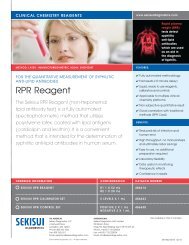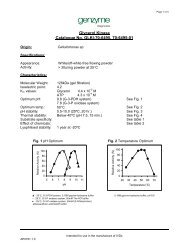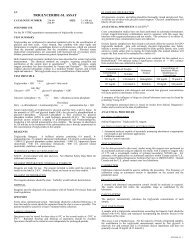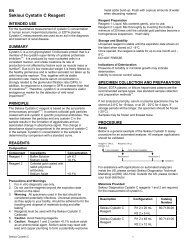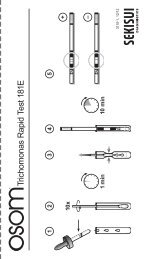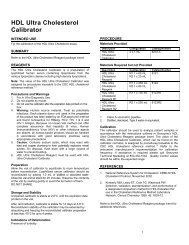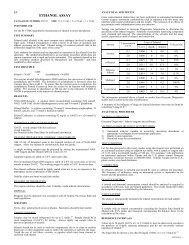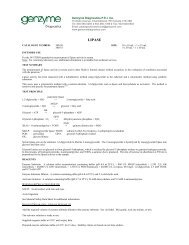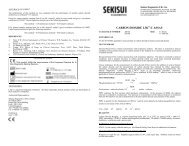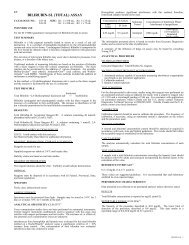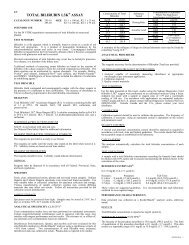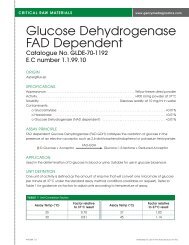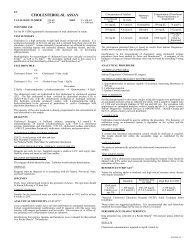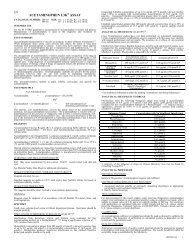OSOM Strep A Test Kit 141 MSDS - Sekisui Diagnostics
OSOM Strep A Test Kit 141 MSDS - Sekisui Diagnostics
OSOM Strep A Test Kit 141 MSDS - Sekisui Diagnostics
You also want an ePaper? Increase the reach of your titles
YUMPU automatically turns print PDFs into web optimized ePapers that Google loves.
Corporate Headquarters<br />
Genzyme Corporation<br />
500 Kendall Street<br />
Cambridge, MA 02142<br />
USA<br />
www.genzyme.com<br />
Phone: 617-252-7500<br />
Manufacturer/Distributor<br />
Genzyme <strong>Diagnostics</strong><br />
6659 Top Gun Street<br />
San Diego, CA 92121<br />
USA<br />
www.genzymediagnostics.com<br />
Phone: 858-452-3198<br />
Distributor<br />
Genzyme <strong>Diagnostics</strong><br />
50 Gibson Drive<br />
Kings Hill, West Malling<br />
Kent ME19 4AF<br />
UK<br />
www.genzymediagnostics.com<br />
Phone: +44 (0) 1732 220022<br />
MATERIAL SAFETY DATA SHEETS<br />
Catalog Number:<br />
<strong>Kit</strong> Name:<br />
<strong>141</strong> <strong>OSOM</strong> ® <strong>Strep</strong> A <strong>Test</strong><br />
mSDS Number:<br />
Component Name:<br />
998 <strong>Strep</strong> A REAG 1<br />
1001 <strong>Strep</strong> A REAG 2<br />
1003 <strong>Strep</strong> A CONTROL +<br />
1009 <strong>Strep</strong> A CONTROL -<br />
Note:<br />
The page numbers on the 4 individual <strong>MSDS</strong>s for this kit are specific to each document. There<br />
are a total of 21 pages including this cover sheet.<br />
<strong>OSOM</strong>® <strong>Strep</strong> A <strong>Test</strong> Stick is an “article” and does not require an <strong>MSDS</strong>.<br />
Effective Date: April 2, 2010
MATERIAL SAFETY DATA SHEET<br />
1. Product and Company Identification<br />
Product name <strong>Strep</strong> A REAG 1<br />
Synonym(s) <strong>OSOM</strong>® <strong>Strep</strong> A Extraction Reagent 1<br />
CAS #<br />
Mixture<br />
<strong>Kit</strong> Number: <strong>141</strong>; <strong>141</strong>E; <strong>141</strong>E-20<br />
Product description<br />
Product use<br />
Corporate Headquarters<br />
Genzyme Corporation<br />
500 Kendall Street<br />
Cambridge, MA 02142 USA<br />
www.genzyme.com<br />
Phone: 617-252-7500<br />
Distributor<br />
Genzyme <strong>Diagnostics</strong><br />
50 Gibson Drive<br />
Kings Hill, West Malling<br />
Kent ME19 4AF UK<br />
www.genzymediagnostics.com<br />
Phone: 44 (0) 1732 220022<br />
2. Hazards Identification<br />
Aqueous, alkaline solution containing trace color indicator.<br />
Component of <strong>OSOM</strong>® <strong>Strep</strong> A <strong>Test</strong> kit. For the qualitative detection of Group A <strong>Strep</strong>tococcal<br />
antigen from throat swabs or confirmation of presumptive Group A <strong>Strep</strong>tococcal colonies<br />
recovered from culture. For In Vitro Diagnostic Use Only.<br />
Manufacturer/Distributor<br />
Genzyme <strong>Diagnostics</strong><br />
6659 Top Gun Street<br />
San Diego, CA 92121 USA<br />
www.genzymediagnostics.com<br />
Phone: 858-452-3198<br />
Emergency Telephone Numbers<br />
Genzyme (U.S.): 617-562-4555<br />
CHEMTREC (U.S.): 800-424-9300<br />
CHEMTREC (Outside U.S.): +1 703-527-3887<br />
Regulatory status This preparation is classified as hazardous under U.S. OSHA 29 CFR 1910.1200.<br />
Precautionary statements<br />
Potential health effects<br />
Inhalation<br />
Eyes<br />
Skin<br />
Ingestion<br />
Chronic effects<br />
Target organs<br />
Potential environmental effects See Section 12.<br />
3. Composition / Information on Ingredients<br />
This medical diagnostic kit is controlled under the Canadian Food and Drugs Act and is exempt<br />
from classification, labeling and <strong>MSDS</strong> requirements under the Canadian Hazardous Products Act<br />
and Controlled Products Regulations.<br />
WARNING! The chemical, physical and toxicological properties of this preparation have not been<br />
thoroughly characterized. Toxic by ingestion. Avoid contact with eyes and skin. Do not ingest or<br />
inhale. Preparation appearance: clear, pink liquid.<br />
No data available. Substantial aerosol inhalation may result in symptoms similar to those<br />
specified for ingestion.<br />
No data available. Eye exposure may cause severe irritation, redness, watering, swelling and<br />
burning.<br />
No data available. Skin contact with sufficient chemical absorption may result in symptoms similar<br />
to those specified for ingestion.<br />
Ingestion of sodium nitrite may cause gastric irritation, nausea, vomiting and abdominal pain.<br />
Significant exposure may result in a drop in blood pressure, headache, dizziness, rapid pulse and<br />
visual problems. Skin may be flushed and sweaty and then become cold. Skin and lips may turn<br />
blue.<br />
Chronic exposure to nitrites may cause headaches, visual problems and decreased blood<br />
pressure.<br />
Sodium nitrite: Cardiovascular and central nervous systems.<br />
Components CAS # Percent<br />
Sodium nitrite<br />
7632-00-0 12 - 14<br />
Non-hazardous and other components below reportable levels 80 - 90<br />
<strong>Strep</strong> A REAG 1<br />
<strong>MSDS</strong> Number 998 Version #: 10 Revision date: 04-02-2010<br />
<strong>MSDS</strong> US<br />
1 / 5
4. First Aid Measures<br />
First aid procedures<br />
Inhalation<br />
Eye contact<br />
Skin contact<br />
Ingestion<br />
If inhaled, move from exposure area to fresh air. Seek medical attention if breathing becomes<br />
difficult or if cough or other symptoms develop.<br />
Immediately flush eyes with plenty of tepid water for 15 minutes while separating eyelids with<br />
fingers. Remove contact lenses if worn. Obtain immediate medical attention.<br />
In case of contact, immediately flush skin with cool water and remove contaminated clothing.<br />
Obtain medical attention if needed or if irritation or other symptoms develop.<br />
In case of ingestion, contact a poison control center or physician for instructions.<br />
5. Fire Fighting Measures<br />
Extinguishing media<br />
Suitable extinguishing<br />
media<br />
Unsuitable extinguishing<br />
media<br />
Specific hazards<br />
Hazardous combustion<br />
products<br />
Protection of firefighters<br />
Protective equipment and<br />
precautions for firefighters<br />
Use extinguishing media suitable for surrounding fire, such as carbon dioxide, chemical foam, dry<br />
chemical or water spray.<br />
Unknown.<br />
Sodium nitrite is an oxidizing agent. It is not flammable itself, but it can make combustible<br />
materials more flammable if it is absorbed and dries.<br />
When heated to decomposition, may produce carbon monoxide (CO), carbon dioxide (CO2),<br />
nitrogen oxides (NOx) and sulphur oxides (SOx).<br />
Firefighters should wear NIOSH-approved or equivalent Self-Contained Breathing Apparatus and<br />
full protective gear.<br />
6. Accidental Release Measures<br />
Personal precautions<br />
Environmental precautions<br />
Methods for cleaning up<br />
Wear Personal Protective Equipment (PPE) as indicated in Section 8. Ensure adequate<br />
ventilation. Avoid physical contact with material and avoid aerosol inhalation. Wash hands<br />
thoroughly after handling.<br />
Do not let product enter drains.<br />
Absorb spill with inert material/sorbent. Decontaminate the spill site following standard<br />
procedures. Dispose of materials in accordance with all applicable federal, state, local and<br />
provincial environmental regulations, per Section 13.<br />
7. Handling and Storage<br />
Handling<br />
Storage<br />
Follow good laboratory hygiene practices. See Section 8, Engineering Controls. Mixing <strong>Strep</strong> A<br />
Reagents 1 and 2 yields nitrous acid, which may immediately decompose into toxic nitrous gas, a<br />
short-term reaction by-product. Minimize contact and contamination of personal clothing and skin.<br />
Avoid vapor or aerosol inhalation. Wash hands thoroughly after handling.<br />
Store at 15 to 30°C (59 to 86°F). Keep container tightly closed in a dry and well-ventilated place.<br />
Do not store with incompatible substances; see Section 10.<br />
8. Exposure Controls / Personal Protection<br />
Exposure guidelines<br />
Engineering controls<br />
Personal protective equipment<br />
Respiratory protection<br />
Eye / face protection<br />
Skin protection<br />
Hand protection<br />
General<br />
There are no ACGIH, NIOSH or OSHA occupational exposure limits currently established for this<br />
mixture or its components at concentrations equal to or greater than 1% (0.1% if carcinogen).<br />
Minimize potential for aerosolization. Handle within a containment system or with local exhaust<br />
ventilation. Facilities storing or using this material should be equipped with an eyewash fountain<br />
and a safety shower.<br />
A respirator is not expected to be required under normal conditions of use.<br />
Wear appropriate protective chemical safety goggles.<br />
Wear appropriate protective clothing, such as a lab coat or other long-sleeved garment over<br />
clothing to minimize contact and contamination of clothing.<br />
Wear chemical resistant protective gloves.<br />
Follow company-specific safety procedures.<br />
9. Physical & Chemical Properties<br />
Physical state<br />
Color<br />
Liquid.<br />
Clear, pink<br />
<strong>Strep</strong> A REAG 1<br />
<strong>MSDS</strong> Number 998 Version #: 10 Revision date: 04-02-2010<br />
<strong>MSDS</strong> US<br />
2 / 5
Odor<br />
Chemical family<br />
pH<br />
Melting point<br />
Freezing point<br />
Boiling point<br />
Flash point<br />
Evaporation rate<br />
Flammability<br />
Flammability limits in air,<br />
upper, % by volume<br />
Flammability limits in air,<br />
lower, % by volume<br />
Vapor pressure<br />
Vapor density<br />
Specific gravity 1.08<br />
Relative density<br />
Solubility (water)<br />
Partition coefficient<br />
(n-octanol/water)<br />
Auto-ignition temperature<br />
Decomposition temperature<br />
Viscosity<br />
Not available<br />
Alkaline solution<br />
9.0 (approximate)<br />
Not applicable<br />
Not available<br />
Not available<br />
Not available<br />
Not available<br />
Not available.<br />
Not available<br />
Not available<br />
Not available<br />
Not available<br />
1.08 g/cm3<br />
Water-soluble<br />
Not available<br />
Not applicable<br />
Not available<br />
Not available<br />
10. Chemical Stability & Reactivity Information<br />
Reactivity<br />
Mixing <strong>Strep</strong> A Reagents 1 and 2 yields nitrous acid, which may immediately decompose into<br />
toxic nitrous gas, a short-term reaction by-product.<br />
Chemical stability Stable under ordinary conditions of use and storage. See Section 7.<br />
Possibility of hazardous<br />
reactions<br />
Conditions to avoid<br />
Incompatible materials<br />
Hazardous decomposition<br />
products<br />
11. Toxicological Information<br />
Hazardous polymerization will not occur.<br />
Solution is oxidized by air. Avoid high temperatures.<br />
Avoid amines, ammonium salts, cyanides and reducing agents. Heat and acids will result in<br />
release of nitrous gas. Under certain conditions, nitrite compounds may react with secondary and<br />
tertiary amines to form nitrosamines, which are known carcinogens in animals.<br />
Thermal decomposition may lead to release of irritating gases and vapors.<br />
Routes of exposure<br />
Acute effects<br />
Toxicological data<br />
Components<br />
Sodium nitrite (7632-00-0)<br />
Occupational exposure routes may include inhalation, skin absorption, and eye and skin contact.<br />
Sodium nitrite exposure may result in a drop in blood pressure, headache, vertigo, palpitations,<br />
visual disturbances, methemoglobinemia, dyspnea and respiratory depression.<br />
<strong>Test</strong> Results<br />
Acute Inhalation LC50 Rat: 5.5 mg/l 4 Hours<br />
Acute Oral LD50 Rat: 85 mg/kg<br />
* Estimates for product may be based on additional component data not shown.<br />
Skin corrosion/irritation No data available.<br />
Chronic effects<br />
No data available.<br />
Carcinogenicity<br />
No data available.<br />
Mutagenicity<br />
No data available.<br />
Reproductive effects<br />
No data available.<br />
Teratogenicity<br />
No data available.<br />
Sensitization<br />
No data available.<br />
<strong>Strep</strong> A REAG 1<br />
<strong>MSDS</strong> Number 998 Version #: 10 Revision date: 04-02-2010<br />
<strong>MSDS</strong> US<br />
3 / 5
12. Ecological Information<br />
Ecotoxicological data<br />
Components<br />
Sodium nitrite (7632-00-0)<br />
<strong>Test</strong> Results<br />
EC50 Greasyback shrimp (Metapenaeus ensis): 16.14 - 26.61<br />
mg/l 48 hours<br />
LC50 Channel catfish (Ictalurus punctatus): 0.048 mg/l 96<br />
hours<br />
LC50 Rainbow trout,donaldson trout (Oncorhynchus mykiss):<br />
0.19 - 0.24 mg/l 96 hours<br />
* Estimates for product may be based on additional component data not shown.<br />
Mobility in environmental<br />
media<br />
Persistence / degradability<br />
Bioaccumulation<br />
13. Disposal Considerations<br />
Disposal instructions<br />
14. Transport Information<br />
DOT<br />
Basic shipping requirements:<br />
UN number<br />
Proper shipping name<br />
Hazard class<br />
No data available.<br />
No data available.<br />
No data available.<br />
Dispose of unused product, spilled material and waste in accordance with all applicable federal,<br />
state, local and provincial environmental and hazardous waste regulations.<br />
UN1500<br />
SODIUM NITRITE SOLUTION<br />
5.1 (6.1)<br />
DOT<br />
15. Regulatory Information<br />
US federal regulations<br />
This preparation is a component of an FDA-regulated in vitro diagnostic device.<br />
US CERCLA Hazardous Substances: Listed substance<br />
Sodium nitrite (7632-00-0)<br />
LISTED<br />
US CERCLA Hazardous Substances: Reportable quantity<br />
Sodium nitrite (7632-00-0)<br />
100 LBS<br />
US CWA Section 311 Hazardous Substances: Listed substance<br />
Sodium nitrite (7632-00-0)<br />
Listed.<br />
US CWA Section 311 Reporting Quantities of Hazardous Substances: Listed substance<br />
Sodium nitrite (7632-00-0)<br />
Listed.<br />
US CWA Section 311 Reporting Quantities of Hazardous Substances: Reportable quantity<br />
Sodium nitrite (7632-00-0)<br />
100 LBS<br />
US EPCRA (SARA Title III) Section 313 - Toxic Chemical: De minimis concentration<br />
Sodium nitrite (7632-00-0)<br />
1.0 %<br />
US EPCRA (SARA Title III) Section 313 - Toxic Chemical: Listed substance<br />
Sodium nitrite (7632-00-0)<br />
US TSCA Inventory: Registration Status<br />
Listed.<br />
Sodium nitrite (7632-00-0)<br />
Listed.<br />
US TSCA Section 12(b) Export Notification: Export Notification requirement/De minimis concentration<br />
Sodium nitrite (7632-00-0)<br />
1.0 % TSCA Section: 5 One-Time Export Notification only.<br />
<strong>Strep</strong> A REAG 1<br />
<strong>MSDS</strong> Number 998 Version #: 10 Revision date: 04-02-2010<br />
<strong>MSDS</strong> US<br />
4 / 5
US TSCA Section 5(a)(2) Final Significant New Use Rules (SNURs): Listed substance<br />
Sodium nitrite (7632-00-0)<br />
Listed.<br />
US TSCA Section 5(a)(2) Final Significant New Use Rules (SNURs): Section number: 40 CFR<br />
Sodium nitrite (7632-00-0)<br />
CERCLA (Superfund) reportable quantity<br />
Sodium nitrite: 100<br />
721.4740 Listed.<br />
Superfund Amendments and Reauthorization Act of 1986 (SARA)<br />
Hazard categories<br />
Immediate Hazard - No<br />
Delayed Hazard - No<br />
Fire Hazard - No<br />
Pressure Hazard - No<br />
Reactivity Hazard - No<br />
Section 302 extremely<br />
hazardous substance<br />
Section 311 hazardous<br />
chemical<br />
State regulations<br />
No<br />
No<br />
US - California Hazardous Substances (Director's): Listed substance<br />
Sodium nitrite (7632-00-0)<br />
16. Other Information<br />
Listed.<br />
Further information<br />
This <strong>MSDS</strong> has been prepared in accordance with the ANSI Z400.1 format and complies with the<br />
U.S. OSHA Hazard Communication Standard 29 CFR 1910.1200.<br />
<strong>MSDS</strong> Number 998<br />
Version number 10<br />
Issue date 04-02-2010<br />
Revision date 04-02-2010<br />
The Product name in Section 1 has been revised.<br />
The Transport information in Section 14 has been revised.<br />
Disclaimer<br />
The information above is provided in good faith. It is believed to be accurate and represents the<br />
best information currently available to us. HOWEVER, WE MAKE NO WARRANTY OF<br />
MERCHANTABILITY, FITNESS FOR A PARTICULAR PURPOSE OR OF ANY OTHER TYPE,<br />
EXPRESSED OR IMPLIED, WITH RESPECT TO PRODUCTS DESCRIBED OR DATA OR<br />
INFORMATION PROVIDED, AND WE ASSUME NO LIABILITY RESULTING FROM THE USE OF<br />
SUCH PRODUCTS, DATA OR INFORMATION. Users should make their own investigations to<br />
determine the suitability of the information for their particular purposes, and the user assumes all<br />
risk arising from their use of the material. The user is required to comply with all laws and<br />
regulations relating to the purchase, use, storage and disposal of the material, and must be<br />
familiar with and follow generally accepted safe handling procedures. In no event shall Genzyme<br />
be liable for any claims, losses, or damages of any individual or for lost profits or any special,<br />
indirect, incidental, consequential or exemplary damages, howsoever arising, even if Genzyme<br />
has been advised of the possibility of such damages.<br />
<strong>Strep</strong> A REAG 1<br />
<strong>MSDS</strong> Number 998 Version #: 10 Revision date: 04-02-2010<br />
<strong>MSDS</strong> US<br />
5 / 5
MATERIAL SAFETY DATA SHEET<br />
1. Product and Company Identification<br />
Product name <strong>Strep</strong> A REAG 2<br />
Synonym(s) <strong>OSOM</strong>® <strong>Strep</strong> A Extraction Reagent 2<br />
CAS #<br />
Mixture<br />
<strong>Kit</strong> Number: <strong>141</strong>; <strong>141</strong>E; <strong>141</strong>E-20<br />
Product description<br />
Product use<br />
Corporate Headquarters<br />
Genzyme Corporation<br />
500 Kendall Street<br />
Cambridge, MA 02142 USA<br />
www.genzyme.com<br />
Phone: 617-252-7500<br />
Distributor<br />
Genzyme <strong>Diagnostics</strong><br />
50 Gibson Drive<br />
Kings Hill, West Malling<br />
Kent ME19 4AF UK<br />
www.genzymediagnostics.com<br />
Phone: 44 (0) 1732 220022<br />
2. Hazards Identification<br />
Aqueous, acidic solution.<br />
Component of <strong>OSOM</strong>® <strong>Strep</strong> A <strong>Test</strong> kit. For the qualitative detection of Group A <strong>Strep</strong>tococcal<br />
antigen from throat swabs or confirmation of presumptive Group A <strong>Strep</strong>tococcal colonies<br />
recovered from culture. For In Vitro Diagnostic Use Only.<br />
Manufacturer/Distributor<br />
Genzyme <strong>Diagnostics</strong><br />
6659 Top Gun Street<br />
San Diego, CA 92121 USA<br />
www.genzymediagnostics.com<br />
Phone: 858-452-3198<br />
Emergency Telephone Numbers<br />
Genzyme (U.S.): 617-562-4555<br />
CHEMTREC (U.S.): 800-424-9300<br />
CHEMTREC (Outside U.S.): +1 703-527-3887<br />
Regulatory status This preparation is classified as hazardous under U.S. OSHA 29 CFR 1910.1200.<br />
Precautionary statements<br />
Potential health effects<br />
Inhalation<br />
Eyes<br />
Skin<br />
Ingestion<br />
Chronic effects<br />
Target organs<br />
Potential environmental effects<br />
This medical diagnostic kit is controlled under the Canadian Food and Drugs Act and is exempt<br />
from classification, labeling and <strong>MSDS</strong> requirements under the Canadian Hazardous Products Act<br />
and Controlled Products Regulations.<br />
The chemical, physical and toxicological properties of this preparation have not been thoroughly<br />
characterized. May be irritating to eyes, respiratory system and skin. Avoid contact with eyes and<br />
skin. Do not ingest or inhale. Preparation appearance: clear, colorless liquid.<br />
Inhalation may be irritating to the nasal passages and throat.<br />
Eye exposure may cause irritation, redness, watering and pain.<br />
Prolonged skin contact may cause skin irritation with discomfort and rash.<br />
If large amounts are ingested, symptoms may include digestive irritation and discomfort.<br />
Prolonged or repeated skin contact may cause chronic irritation.<br />
Eyes and skin.<br />
None expected.<br />
3. Composition / Information on Ingredients<br />
Components CAS # Percent<br />
Acetic acid<br />
64-19-7 2<br />
Non-hazardous and other components below reportable levels > 90<br />
4. First Aid Measures<br />
First aid procedures<br />
Inhalation<br />
If inhaled, move from exposure area to fresh air. Seek medical attention if breathing becomes<br />
difficult or if cough or other symptoms develop.<br />
<strong>Strep</strong> A REAG 2<br />
<strong>MSDS</strong> Number 1001 Version #: 10 Revision date: 04-02-2010<br />
<strong>MSDS</strong> US<br />
1 / 5
Eye contact<br />
Skin contact<br />
Ingestion<br />
5. Fire Fighting Measures<br />
Extinguishing media<br />
Suitable extinguishing<br />
media<br />
Unsuitable extinguishing<br />
media<br />
Specific hazards<br />
Hazardous combustion<br />
products<br />
Protection of firefighters<br />
Protective equipment and<br />
precautions for firefighters<br />
Immediately flush eyes with plenty of tepid water for 15 minutes while separating eyelids with<br />
fingers. Remove contact lenses if worn. Obtain immediate medical attention.<br />
In case of contact, flush skin with cool water and remove contaminated clothing. Obtain medical<br />
attention if needed or if irritation or other symptoms develop.<br />
In case of ingestion, contact a poison control center or physician for instructions.<br />
Use extinguishing media suitable for surrounding fire, such as carbon dioxide, chemical foam, dry<br />
chemical or water spray.<br />
Unknown.<br />
Dilute aqueous solution not considered a fire hazard.<br />
When heated to decomposition, may produce carbon dioxide (CO2) and carbon monoxide (CO).<br />
Firefighters should wear NIOSH-approved or equivalent Self-Contained Breathing Apparatus and<br />
full protective gear.<br />
6. Accidental Release Measures<br />
Personal precautions<br />
Environmental precautions<br />
Methods for cleaning up<br />
Wear Personal Protective Equipment (PPE) as indicated in Section 8. Ensure adequate<br />
ventilation. Avoid physical contact with material and avoid aerosol inhalation. Wash hands<br />
thoroughly after handling.<br />
No special environmental precautions required.<br />
Absorb spill with inert material/sorbent or appropriate neutralizing agent. Decontaminate the spill<br />
site following standard procedures. Dispose of materials in accordance with all applicable federal,<br />
state, local and provincial environmental regulations, per Section 13.<br />
7. Handling and Storage<br />
Handling<br />
Storage<br />
Mixing <strong>Strep</strong> A Reagents 1 and 2 yields nitrous acid, which may immediately decompose into<br />
toxic nitrous gas, a short-term reaction by-product. Follow good laboratory hygiene practices. See<br />
Section 8, Engineering Controls. Avoid vapor or aerosol inhalation. Minimize contact and<br />
contamination of personal clothing and skin. Wash hands thoroughly after handling.<br />
Store at 15 to 30°C (59 to 86°F). Keep container tightly closed. Do not store with incompatible<br />
substances; see Section 10.<br />
8. Exposure Controls / Personal Protection<br />
Occupational exposure limits<br />
ACGIH<br />
Components Type Value<br />
Acetic acid (64-19-7)<br />
STEL<br />
15 ppm<br />
TWA<br />
10 ppm<br />
U.S. - OSHA<br />
Components Type Value<br />
Acetic acid (64-19-7)<br />
PEL<br />
25 mg/m3<br />
TWA<br />
10 ppm<br />
25 mg/m3<br />
10 ppm<br />
Engineering controls<br />
Personal protective equipment<br />
Respiratory protection<br />
Eye / face protection<br />
Skin protection<br />
Hand protection<br />
Minimize potential for aerosolization. Handle within a containment system or with local exhaust<br />
ventilation. Facilities storing or using this preparation should be equipped with an eyewash<br />
fountain and a safety shower.<br />
A respirator is not expected to be required under normal conditions of use.<br />
Wear appropriate protective chemical safety goggles.<br />
Wear lab coat or other protective garments. Remove contaminated clothing promptly.<br />
Wear chemical resistant protective gloves.<br />
<strong>Strep</strong> A REAG 2<br />
<strong>MSDS</strong> Number 1001 Version #: 10 Revision date: 04-02-2010<br />
<strong>MSDS</strong> US<br />
2 / 5
General<br />
Follow company-specific safety procedures.<br />
9. Physical & Chemical Properties<br />
Physical state<br />
Color<br />
Odor<br />
Chemical family<br />
pH<br />
Melting point<br />
Freezing point<br />
Boiling point<br />
Flash point<br />
Evaporation rate<br />
Flammability<br />
Flammability limits in air,<br />
upper, % by volume<br />
Flammability limits in air,<br />
lower, % by volume<br />
Vapor pressure<br />
Vapor density<br />
Specific gravity<br />
Relative density<br />
Solubility (water)<br />
Partition coefficient<br />
(n-octanol/water)<br />
Auto-ignition temperature<br />
Decomposition temperature<br />
Viscosity<br />
Liquid.<br />
Clear, colorless<br />
Sour, pungent odor like vinegar<br />
Acidic solution<br />
2.6 (approximate)<br />
Not applicable<br />
Not available<br />
Not available<br />
Not available<br />
Not available<br />
Not available.<br />
Not available<br />
Not available<br />
Not available<br />
Not available<br />
Not available<br />
Not available<br />
Water-soluble<br />
Not available<br />
Not applicable<br />
Not available<br />
Not available<br />
10. Chemical Stability & Reactivity Information<br />
Reactivity<br />
Mixing <strong>Strep</strong> A Reagents 1 and 2 yields nitrous acid, which may immediately decompose into<br />
toxic nitrous gas, a short-term reaction by-product.<br />
Chemical stability Stable under ordinary conditions of use and storage. See Section 7.<br />
Possibility of hazardous<br />
reactions<br />
Conditions to avoid<br />
Incompatible materials<br />
Hazardous decomposition<br />
products<br />
11. Toxicological Information<br />
Routes of exposure<br />
Toxicological data<br />
Components<br />
Acetic acid (64-19-7)<br />
Hazardous polymerization will not occur.<br />
None known.<br />
Avoid strong oxidizing agents, most common metals (except aluminum), strong bases and<br />
amines.<br />
Thermal decomposition may lead to release of irritating gases and vapors.<br />
Occupational exposure routes may include inhalation, eye and skin contact.<br />
<strong>Test</strong> Results<br />
* Estimates for product may be based on additional component data not shown.<br />
Local effects<br />
Eye irritation<br />
Acetic acid (64-19-7)<br />
Acetic acid (64-19-7)<br />
Acute Dermal LD50 Rabbit: 1060 mg/kg<br />
Acute Inhalation LC50 Guinea pig: 5000 mg/l 1 Hours<br />
Acute Oral LD50 Rat: 3530 mg/kg<br />
Eye irritation has been noted at a concentration below 10 ppm. Irritating<br />
Irritating<br />
<strong>Strep</strong> A REAG 2<br />
<strong>MSDS</strong> Number 1001 Version #: 10 Revision date: 04-02-2010<br />
<strong>MSDS</strong> US<br />
3 / 5
Local effects<br />
Skin Irritation<br />
Acetic acid (64-19-7)<br />
Chronic effects<br />
Carcinogenicity<br />
Mutagenicity<br />
Reproductive effects<br />
Teratogenicity<br />
Sensitization<br />
Strongly Irritating<br />
Prolonged or repeated skin contact may cause dermatitis.<br />
No data available.<br />
No data available.<br />
No data available.<br />
No data available.<br />
No data available.<br />
12. Ecological Information<br />
Ecotoxicological data<br />
Components<br />
Acetic acid (64-19-7)<br />
<strong>Test</strong> Results<br />
EC50 Water flea (Daphnia magna): 65 mg/l 48 hours<br />
LC50 Bluegill (Lepomis macrochirus): 75 mg/l 96 hours<br />
* Estimates for product may be based on additional component data not shown.<br />
Mobility in environmental<br />
media<br />
Persistence / degradability<br />
Bioaccumulation<br />
13. Disposal Considerations<br />
No data available.<br />
No data available.<br />
No data available.<br />
Disposal instructions<br />
Dispose of unused product, spilled material and waste in accordance with all applicable federal,<br />
state, local and provincial environmental and hazardous waste regulations.<br />
14. Transport Information<br />
DOT<br />
Not regulated as hazardous goods.<br />
15. Regulatory Information<br />
US federal regulations<br />
This preparation is a component of an FDA-regulated in vitro diagnostic device.<br />
US CAA Section 111 Volatile Organic Compounds: Listed substance<br />
Acetic acid (64-19-7)<br />
Listed.<br />
US CERCLA Hazardous Substances: Listed substance<br />
Acetic acid (64-19-7)<br />
LISTED<br />
US CERCLA Hazardous Substances: Reportable quantity<br />
Acetic acid (64-19-7)<br />
5000 LBS<br />
US CWA Section 311 Hazardous Substances: Listed substance<br />
Acetic acid (64-19-7)<br />
Listed.<br />
US CWA Section 311 Reporting Quantities of Hazardous Substances: Listed substance<br />
Acetic acid (64-19-7)<br />
Listed.<br />
US CWA Section 311 Reporting Quantities of Hazardous Substances: Reportable quantity<br />
Acetic acid (64-19-7)<br />
5000 LBS<br />
US OSHA Hazard Communication Standard: Listed substance<br />
Acetic acid (64-19-7)<br />
US TSCA Inventory: Registration Status<br />
Acetic acid (64-19-7)<br />
CERCLA (Superfund) reportable quantity<br />
Acetic acid: 5000<br />
Listed.<br />
Listed.<br />
Superfund Amendments and Reauthorization Act of 1986 (SARA)<br />
Hazard categories<br />
Immediate Hazard - No<br />
Delayed Hazard - No<br />
Fire Hazard - No<br />
Pressure Hazard - No<br />
Reactivity Hazard - No<br />
<strong>Strep</strong> A REAG 2<br />
<strong>MSDS</strong> Number 1001 Version #: 10 Revision date: 04-02-2010<br />
<strong>MSDS</strong> US<br />
4 / 5
Section 302 extremely<br />
hazardous substance<br />
Section 311 hazardous<br />
chemical<br />
State regulations<br />
No<br />
No<br />
US - California Hazardous Substances (Director's): Listed substance<br />
Acetic acid (64-19-7)<br />
16. Other Information<br />
Listed.<br />
Further information<br />
This <strong>MSDS</strong> has been prepared in accordance with the ANSI Z400.1 format and complies with the<br />
U.S. OSHA Hazard Communication Standard 29 CFR 1910.1200.<br />
<strong>MSDS</strong> Number 1001<br />
Version number 10<br />
Issue date 04-02-2010<br />
Revision date 04-02-2010<br />
Disclaimer<br />
The Product name in Section 1 has been revised.<br />
The Transport information in Section 14 has been revised.<br />
The information above is provided in good faith. It is believed to be accurate and represents the<br />
best information currently available to us. HOWEVER, WE MAKE NO WARRANTY OF<br />
MERCHANTABILITY, FITNESS FOR A PARTICULAR PURPOSE OR OF ANY OTHER TYPE,<br />
EXPRESSED OR IMPLIED, WITH RESPECT TO PRODUCTS DESCRIBED OR DATA OR<br />
INFORMATION PROVIDED, AND WE ASSUME NO LIABILITY RESULTING FROM THE USE OF<br />
SUCH PRODUCTS, DATA OR INFORMATION. Users should make their own investigations to<br />
determine the suitability of the information for their particular purposes, and the user assumes all<br />
risk arising from their use of the material. The user is required to comply with all laws and<br />
regulations relating to the purchase, use, storage and disposal of the material, and must be<br />
familiar with and follow generally accepted safe handling procedures. In no event shall Genzyme<br />
be liable for any claims, losses, or damages of any individual or for lost profits or any special,<br />
indirect, incidental, consequential or exemplary damages, howsoever arising, even if Genzyme<br />
has been advised of the possibility of such damages.<br />
<strong>Strep</strong> A REAG 2<br />
<strong>MSDS</strong> Number 1001 Version #: 10 Revision date: 04-02-2010<br />
<strong>MSDS</strong> US<br />
5 / 5
MATERIAL SAFETY DATA SHEET<br />
1. Product and Company Identification<br />
Product name <strong>Strep</strong> A CONTROL +<br />
Synonym(s)<br />
CAS #<br />
<strong>OSOM</strong>® <strong>Strep</strong> A Positive Control<br />
Mixture<br />
<strong>Kit</strong> Number: <strong>141</strong>; <strong>141</strong>E; <strong>141</strong>E-20; 147; 149<br />
Product description<br />
Product use<br />
Corporate Headquarters<br />
Genzyme Corporation<br />
500 Kendall Street<br />
Cambridge, MA 02142 USA<br />
www.genzyme.com<br />
Phone: 617-252-7500<br />
Distributor<br />
Genzyme <strong>Diagnostics</strong><br />
50 Gibson Drive<br />
Kings Hill, West Malling<br />
Kent ME19 4AF UK<br />
www.genzymediagnostics.com<br />
Phone: 44 (0) 1732 220022<br />
2. Hazards Identification<br />
Aqueous solution containing heat-inactivated bacteria and preservative.<br />
Component of <strong>OSOM</strong>® <strong>Strep</strong> A <strong>Test</strong> and <strong>OSOM</strong>® Ultra <strong>Strep</strong> A <strong>Test</strong>. For external quality control<br />
testing. For In Vitro Diagnostic Use Only.<br />
Manufacturer/Distributor<br />
Genzyme <strong>Diagnostics</strong><br />
6659 Top Gun Street<br />
San Diego, CA 92121 USA<br />
www.genzymediagnostics.com<br />
Phone: 858-452-3198<br />
Emergency Telephone Numbers<br />
Genzyme (U.S.): 617-562-4555<br />
CHEMTREC (U.S.): 800-424-9300<br />
CHEMTREC (Outside U.S.): +1 703-527-3887<br />
Regulatory status This preparation is not classified as hazardous under U.S. OSHA 29 CFR 1910.1200.<br />
Precautionary statements<br />
Potential health effects<br />
Inhalation<br />
Eyes<br />
Skin<br />
Ingestion<br />
Chronic effects<br />
Target organs<br />
This medical diagnostic kit is controlled under the Canadian Food and Drugs Act and is exempt<br />
from classification, labeling and <strong>MSDS</strong> requirements under the Canadian Hazardous Products Act<br />
and Controlled Products Regulations.<br />
CAUTION! The chemical, physical and toxicological properties of this preparation have not been<br />
thoroughly characterized. Avoid contact with eyes and skin. Do not ingest or inhale. Preparation<br />
appearance: clear, colorless liquid.<br />
No data available.<br />
No data available. Eye exposure may cause irritation, redness and watering.<br />
No data available. Skin contact may cause irritation, dryness and redness. Sodium azide may be<br />
absorbed through the skin and result in systemic effects.<br />
Ingestion of sodium azide may cause nausea, diarrhea, vomiting, headache, slight lowering of<br />
blood pressure, abdominal pain, and a general feeling of apprehension and unwellness.<br />
No data available.<br />
Potential environmental effects See Section 12.<br />
3. Composition / Information on Ingredients<br />
Sodium azide: Cardiovascular and central nervous system.<br />
Components CAS # Percent<br />
Sodium azide<br />
26628-22-8 0.1<br />
Non-hazardous and other components below reportable levels > 90<br />
4. First Aid Measures<br />
First aid procedures<br />
Inhalation<br />
If inhaled, move from exposure area to fresh air. Seek medical attention if breathing becomes<br />
difficult or if cough or other symptoms develop.<br />
<strong>Strep</strong> A CONTROL +<br />
<strong>MSDS</strong> Number 1003 Version #: 10 Revision date: 04-02-2010<br />
<strong>MSDS</strong> US<br />
1 / 5
Eye contact<br />
Skin contact<br />
Ingestion<br />
5. Fire Fighting Measures<br />
Extinguishing media<br />
Suitable extinguishing<br />
media<br />
Unsuitable extinguishing<br />
media<br />
Specific hazards<br />
Hazardous combustion<br />
products<br />
Protection of firefighters<br />
Protective equipment and<br />
precautions for firefighters<br />
Flush eyes with plenty of tepid water for 15 minutes while separating eyelids with fingers. Remove<br />
contact lenses if worn. Obtain medical attention if needed or if symptoms, such as redness or<br />
irritation persist.<br />
In case of contact, flush skin with copious amounts of cool water and remove contaminated<br />
clothing. Obtain medical attention if needed or if irritation or other symptoms develop.<br />
In case of ingestion, contact a poison control center or physician for instructions.<br />
Use extinguishing media suitable for surrounding fire, such as carbon dioxide, chemical foam, dry<br />
chemical or water spray.<br />
Unknown.<br />
Dilute aqueous solution not considered a fire hazard.<br />
When heated to decomposition, may produce hydrazoic acid fumes.<br />
Firefighters should wear NIOSH-approved or equivalent Self-Contained Breathing Apparatus and<br />
full protective gear.<br />
6. Accidental Release Measures<br />
Personal precautions<br />
Environmental precautions<br />
Methods for cleaning up<br />
7. Handling and Storage<br />
Handling<br />
Wear Personal Protective Equipment (PPE) as indicated in Section 8. Avoid physical contact with<br />
material and avoid aerosol inhalation. Wash hands thoroughly after handling.<br />
This preparation contains a small amount of sodium azide which can react with copper, lead,<br />
brass or solder in plumbing systems and form potentially explosive metal azides. Follow proper<br />
disposal procedures.<br />
Absorb spill with inert material/sorbent. Decontaminate the spill site following standard<br />
procedures. Dispose of materials in accordance with all applicable federal, state, local and<br />
provincial environmental regulations, per Section 13.<br />
Follow good laboratory hygiene practices. See Section 8, Engineering Controls. Minimize contact<br />
and contamination of personal clothing and skin. Wash hands thoroughly after handling.<br />
Storage Store at 15 to 30°C (59 to 86°F). Do not store with incompatible substances; see Section 10.<br />
8. Exposure Controls / Personal Protection<br />
Occupational exposure limits<br />
ACGIH<br />
Components Type Value<br />
Sodium azide (26628-22-8)<br />
Ceiling<br />
TWA<br />
0.11 ppm<br />
0.29 mg/m3<br />
U.S. - OSHA<br />
Components Type Value<br />
Sodium azide (26628-22-8)<br />
Ceiling<br />
0.1 ppm<br />
0.3 mg/m3<br />
Engineering controls<br />
Personal protective equipment<br />
Respiratory protection<br />
Eye / face protection<br />
Skin protection<br />
Hand protection<br />
General<br />
This preparation is aqueous and non-volatile and is not expected to require special ventilation<br />
measures. Facilities storing or using this preparation should be equipped with an eyewash<br />
fountain and a safety shower.<br />
A respirator is not expected to be required under normal conditions of use.<br />
Wear appropriate protective chemical safety glasses or goggles.<br />
Wear lab coat or other protective garments. Remove contaminated clothing promptly.<br />
Wear chemical resistant protective gloves.<br />
Follow company-specific safety procedures.<br />
<strong>Strep</strong> A CONTROL +<br />
<strong>MSDS</strong> Number 1003 Version #: 10 Revision date: 04-02-2010<br />
<strong>MSDS</strong> US<br />
2 / 5
9. Physical & Chemical Properties<br />
Physical state<br />
Color<br />
Odor<br />
pH<br />
Melting point<br />
Freezing point<br />
Boiling point<br />
Flash point<br />
Evaporation rate<br />
Flammability<br />
Flammability limits in air,<br />
upper, % by volume<br />
Flammability limits in air,<br />
lower, % by volume<br />
Vapor pressure<br />
Vapor density<br />
Specific gravity<br />
Relative density<br />
Solubility (water)<br />
Partition coefficient<br />
(n-octanol/water)<br />
Auto-ignition temperature<br />
Decomposition temperature<br />
Viscosity<br />
Liquid.<br />
Clear, colorless<br />
Not available<br />
7.2 (approximate)<br />
Not applicable<br />
Not available<br />
Not available<br />
Not available<br />
Not available<br />
Not available.<br />
Not available<br />
Not available<br />
Not available<br />
Not available<br />
Not available<br />
Not available<br />
Water-soluble<br />
Not available<br />
Not available<br />
Not available<br />
Not available<br />
10. Chemical Stability & Reactivity Information<br />
Reactivity<br />
Unknown.<br />
Chemical stability Stable under ordinary conditions of use and storage. See Section 7.<br />
Possibility of hazardous<br />
reactions<br />
Conditions to avoid<br />
Incompatible materials<br />
Incompatiblities (NIOSH)<br />
Sodium azide (26628-22-8)<br />
Hazardous decomposition<br />
products<br />
11. Toxicological Information<br />
Hazardous polymerization will not occur.<br />
None known.<br />
Acids, metals, water [Note: Over a period of time, sodium azide may react with copper,<br />
lead, brass, or solder in plumbing systems to form an accumulation of the HIGHLY<br />
EXPLOSIVE compounds of lead azide & copper azide.]<br />
None expected under normal conditions of use.<br />
Routes of exposure<br />
Toxicological data<br />
Components<br />
Sodium azide (26628-22-8)<br />
Occupational exposure routes may include eye contact, skin contact and skin absorption.<br />
<strong>Test</strong> Results<br />
Acute Dermal LD50 Rabbit: 20 mg/kg<br />
Acute Oral LD50 Mouse: 27 mg/kg<br />
Acute Oral LD50 Rat: 27 mg/kg<br />
* Estimates for product may be based on additional component data not shown.<br />
Local effects<br />
No data available.<br />
Chronic effects<br />
No data available.<br />
Carcinogenicity<br />
No data available.<br />
Mutagenicity<br />
No data available.<br />
<strong>Strep</strong> A CONTROL +<br />
<strong>MSDS</strong> Number 1003 Version #: 10 Revision date: 04-02-2010<br />
<strong>MSDS</strong> US<br />
3 / 5
Reproductive effects<br />
Teratogenicity<br />
Sensitization<br />
No data available.<br />
No data available.<br />
No data available.<br />
12. Ecological Information<br />
Ecotoxicological data<br />
Components<br />
Sodium azide (26628-22-8)<br />
<strong>Test</strong> Results<br />
EC50 Water flea (Daphnia pulex): 2.8 - 6.2 mg/l 48 hours<br />
LC50 Bluegill (Lepomis macrochirus): 0.68 mg/l 96 hours<br />
* Estimates for product may be based on additional component data not shown.<br />
Mobility in environmental<br />
media<br />
Persistence / degradability<br />
Bioaccumulation<br />
No data available.<br />
No data available.<br />
No data available.<br />
13. Disposal Considerations<br />
Disposal instructions<br />
This preparation contains a small amount of sodium azide which can react with copper, lead,<br />
brass or solder in plumbing systems and form potentially explosive metal azides. If preparation<br />
enters drain, flush with a large volume of water to prevent azide build-up. Dispose of unused<br />
product, spilled material and waste in accordance with all applicable federal, state, local and<br />
provincial environmental and hazardous waste regulations.<br />
14. Transport Information<br />
DOT<br />
Not regulated as hazardous goods.<br />
15. Regulatory Information<br />
US federal regulations<br />
This preparation is a component of an FDA-regulated in vitro diagnostic device.<br />
US CERCLA Hazardous Substances: Listed substance<br />
Sodium azide (26628-22-8)<br />
LISTED<br />
US CERCLA Hazardous Substances: Reportable quantity<br />
Sodium azide (26628-22-8)<br />
1000 LBS<br />
US EPCRA (SARA Title III) Section 302 - Extremely Hazardous Spill: Reportable quantity<br />
Sodium azide (26628-22-8)<br />
1000 LBS<br />
US EPCRA (SARA Title III) Section 302 - Extremely Hazardous Substance: Listed substance<br />
Sodium azide (26628-22-8)<br />
Listed.<br />
US EPCRA (SARA Title III) Section 312 - Extremely Hazardous: Reporting threshold quantity, lower<br />
Sodium azide (26628-22-8)<br />
500 LBS<br />
US EPCRA (SARA Title III) Section 313 - Toxic Chemical: De minimis concentration<br />
Sodium azide (26628-22-8)<br />
1.0 %<br />
US EPCRA (SARA Title III) Section 313 - Toxic Chemical: Listed substance<br />
Sodium azide (26628-22-8)<br />
Listed.<br />
US OSHA Hazard Communication Standard: Listed substance<br />
Sodium azide (26628-22-8)<br />
US TSCA Inventory: Registration Status<br />
Sodium azide (26628-22-8)<br />
CERCLA (Superfund) reportable quantity<br />
Sodium azide: 1000<br />
Listed.<br />
Listed.<br />
Superfund Amendments and Reauthorization Act of 1986 (SARA)<br />
Hazard categories<br />
Immediate Hazard - No<br />
Delayed Hazard - No<br />
Fire Hazard - No<br />
Pressure Hazard - No<br />
Reactivity Hazard - No<br />
Section 302 extremely<br />
hazardous substance<br />
No<br />
<strong>Strep</strong> A CONTROL +<br />
<strong>MSDS</strong> Number 1003 Version #: 10 Revision date: 04-02-2010<br />
<strong>MSDS</strong> US<br />
4 / 5
Section 311 hazardous<br />
chemical<br />
No<br />
State regulations<br />
US - California Hazardous Substances (Director's): Listed substance<br />
Sodium azide (26628-22-8)<br />
Listed.<br />
16. Other Information<br />
Further information<br />
This <strong>MSDS</strong> has been prepared in accordance with the ANSI Z400.1 format and complies with the<br />
U.S. OSHA Hazard Communication Standard 29 CFR 1910.1200.<br />
<strong>MSDS</strong> Number 1003<br />
Version number 10<br />
Issue date 04-02-2010<br />
Revision date 04-02-2010<br />
Disclaimer<br />
The Product name in Section 1 has been revised.<br />
The Transport information in Section 14 has been revised.<br />
The information above is provided in good faith. It is believed to be accurate and represents the<br />
best information currently available to us. HOWEVER, WE MAKE NO WARRANTY OF<br />
MERCHANTABILITY, FITNESS FOR A PARTICULAR PURPOSE OR OF ANY OTHER TYPE,<br />
EXPRESSED OR IMPLIED, WITH RESPECT TO PRODUCTS DESCRIBED OR DATA OR<br />
INFORMATION PROVIDED, AND WE ASSUME NO LIABILITY RESULTING FROM THE USE OF<br />
SUCH PRODUCTS, DATA OR INFORMATION. Users should make their own investigations to<br />
determine the suitability of the information for their particular purposes, and the user assumes all<br />
risk arising from their use of the material. The user is required to comply with all laws and<br />
regulations relating to the purchase, use, storage and disposal of the material, and must be<br />
familiar with and follow generally accepted safe handling procedures. In no event shall Genzyme<br />
be liable for any claims, losses, or damages of any individual or for lost profits or any special,<br />
indirect, incidental, consequential or exemplary damages, howsoever arising, even if Genzyme<br />
has been advised of the possibility of such damages.<br />
<strong>Strep</strong> A CONTROL +<br />
<strong>MSDS</strong> Number 1003 Version #: 10 Revision date: 04-02-2010<br />
<strong>MSDS</strong> US<br />
5 / 5
MATERIAL SAFETY DATA SHEET<br />
1. Product and Company Identification<br />
Product name <strong>Strep</strong> A CONTROL -<br />
Synonym(s)<br />
CAS #<br />
<strong>OSOM</strong>® <strong>Strep</strong> A Negative Control<br />
Mixture<br />
<strong>Kit</strong> Number: <strong>141</strong>; <strong>141</strong>E; <strong>141</strong>E-20; 147; 149<br />
Product description<br />
Product use<br />
Corporate Headquarters<br />
Genzyme Corporation<br />
500 Kendall Street<br />
Cambridge, MA 02142 USA<br />
www.genzyme.com<br />
Phone: 617-252-7500<br />
Distributor<br />
Genzyme <strong>Diagnostics</strong><br />
50 Gibson Drive<br />
Kings Hill, West Malling<br />
Kent ME19 4AF UK<br />
www.genzymediagnostics.com<br />
Phone: 44 (0) 1732 220022<br />
2. Hazards Identification<br />
Aqueous solution containing heat-inactivated bacteria and preservative.<br />
Component of <strong>OSOM</strong>® <strong>Strep</strong> A <strong>Test</strong> and <strong>OSOM</strong>® Ultra <strong>Strep</strong> A <strong>Test</strong>. For external quality control<br />
testing. For In Vitro Diagnostic Use Only.<br />
Manufacturer/Distributor<br />
Genzyme <strong>Diagnostics</strong><br />
6659 Top Gun Street<br />
San Diego, CA 92121 USA<br />
www.genzymediagnostics.com<br />
Phone: 858-452-3198<br />
Emergency Telephone Numbers<br />
Genzyme (U.S.): 617-562-4555<br />
CHEMTREC (U.S.): 800-424-9300<br />
CHEMTREC (Outside U.S.): +1 703-527-3887<br />
Regulatory status This preparation is not classified as hazardous under U.S. OSHA 29 CFR 1910.1200.<br />
Precautionary statements<br />
Potential health effects<br />
Inhalation<br />
Eyes<br />
Skin<br />
Ingestion<br />
Chronic effects<br />
Target organs<br />
This medical diagnostic kit is controlled under the Canadian Food and Drugs Act and is exempt<br />
from classification, labeling and <strong>MSDS</strong> requirements under the Canadian Hazardous Products Act<br />
and Controlled Products Regulations.<br />
CAUTION! The chemical, physical and toxicological properties of this preparation have not been<br />
thoroughly characterized. Avoid contact with eyes and skin. Do not ingest or inhale. Preparation<br />
appearance: clear, colorless liquid.<br />
No data available.<br />
No data available. Eye exposure may cause irritation, redness and watering.<br />
No data available. Skin contact may cause irritation, dryness and redness. Sodium azide may be<br />
absorbed through the skin and result in systemic effects.<br />
Ingestion of sodium azide may cause nausea, diarrhea, vomiting, headache, slight lowering of<br />
blood pressure, abdominal pain, and a general feeling of apprehension and unwellness.<br />
No data available.<br />
Potential environmental effects See Section 12.<br />
3. Composition / Information on Ingredients<br />
Sodium azide: Cardiovascular and central nervous system.<br />
Components CAS # Percent<br />
Sodium azide<br />
26628-22-8 0.1<br />
Non-hazardous and other components below reportable levels > 90<br />
4. First Aid Measures<br />
First aid procedures<br />
Inhalation<br />
If inhaled, move from exposure area to fresh air. Seek medical attention if breathing becomes<br />
difficult or if cough or other symptoms develop.<br />
<strong>Strep</strong> A CONTROL -<br />
<strong>MSDS</strong> Number 1009 Version #: 10 Revision date: 04-02-2010<br />
<strong>MSDS</strong> US<br />
1 / 5
Eye contact<br />
Skin contact<br />
Ingestion<br />
5. Fire Fighting Measures<br />
Extinguishing media<br />
Suitable extinguishing<br />
media<br />
Unsuitable extinguishing<br />
media<br />
Specific hazards<br />
Hazardous combustion<br />
products<br />
Protection of firefighters<br />
Protective equipment and<br />
precautions for firefighters<br />
Flush eyes with plenty of tepid water for 15 minutes while separating eyelids with fingers. Remove<br />
contact lenses if worn. Obtain medical attention if needed or if symptoms, such as redness or<br />
irritation persist.<br />
In case of contact, flush skin with copious amounts of cool water and remove contaminated<br />
clothing. Obtain medical attention if needed or if irritation or other symptoms develop.<br />
In case of ingestion, contact a poison control center or physician for instructions.<br />
Use extinguishing media suitable for surrounding fire, such as carbon dioxide, chemical foam, dry<br />
chemical or water spray.<br />
Unknown.<br />
Dilute aqueous solution not considered a fire hazard.<br />
When heated to decomposition, may produce hydrazoic acid fumes.<br />
Firefighters should wear NIOSH-approved or equivalent Self-Contained Breathing Apparatus and<br />
full protective gear.<br />
6. Accidental Release Measures<br />
Personal precautions<br />
Environmental precautions<br />
Methods for cleaning up<br />
7. Handling and Storage<br />
Handling<br />
Wear Personal Protective Equipment (PPE) as indicated in Section 8. Avoid physical contact with<br />
material and avoid aerosol inhalation. Wash hands thoroughly after handling.<br />
This preparation contains a small amount of sodium azide which can react with copper, lead,<br />
brass or solder in plumbing systems and form potentially explosive metal azides. Follow proper<br />
disposal procedures.<br />
Absorb spill with inert material/sorbent. Decontaminate the spill site following standard<br />
procedures. Dispose of materials in accordance with all applicable federal, state, local and<br />
provincial environmental regulations, per Section 13.<br />
Follow good laboratory hygiene practices. See Section 8, Engineering Controls. Minimize contact<br />
and contamination of personal clothing and skin. Wash hands thoroughly after handling.<br />
Storage Store at 15 to 30°C (59 to 86°F). Do not store with incompatible substances; see Section 10.<br />
8. Exposure Controls / Personal Protection<br />
Occupational exposure limits<br />
ACGIH<br />
Components Type Value<br />
Sodium azide (26628-22-8)<br />
Ceiling<br />
TWA<br />
0.11 ppm<br />
0.29 mg/m3<br />
U.S. - OSHA<br />
Components Type Value<br />
Sodium azide (26628-22-8)<br />
Ceiling<br />
0.1 ppm<br />
0.3 mg/m3<br />
Engineering controls<br />
Personal protective equipment<br />
Respiratory protection<br />
Eye / face protection<br />
Skin protection<br />
Hand protection<br />
General<br />
This preparation is aqueous and non-volatile and is not expected to require special ventilation<br />
measures. Facilities storing or using this preparation should be equipped with an eyewash<br />
fountain and a safety shower.<br />
A respirator is not expected to be required under normal conditions of use.<br />
Wear appropriate protective chemical safety glasses or goggles.<br />
Wear lab coat or other protective garments. Remove contaminated clothing promptly.<br />
Wear chemical resistant protective gloves.<br />
Follow company-specific safety procedures.<br />
<strong>Strep</strong> A CONTROL -<br />
<strong>MSDS</strong> Number 1009 Version #: 10 Revision date: 04-02-2010<br />
<strong>MSDS</strong> US<br />
2 / 5
9. Physical & Chemical Properties<br />
Physical state<br />
Color<br />
Odor<br />
pH<br />
Melting point<br />
Freezing point<br />
Boiling point<br />
Flash point<br />
Evaporation rate<br />
Flammability<br />
Flammability limits in air,<br />
upper, % by volume<br />
Flammability limits in air,<br />
lower, % by volume<br />
Vapor pressure<br />
Vapor density<br />
Specific gravity<br />
Relative density<br />
Solubility (water)<br />
Partition coefficient<br />
(n-octanol/water)<br />
Auto-ignition temperature<br />
Decomposition temperature<br />
Viscosity<br />
Liquid.<br />
Clear, colorless<br />
Not available<br />
7.2 (approximate)<br />
Not applicable<br />
Not available<br />
Not available<br />
Not available<br />
Not available<br />
Not available.<br />
Not available<br />
Not available<br />
Not available<br />
Not available<br />
Not available<br />
Not available<br />
Water-soluble<br />
Not available<br />
Not available<br />
Not available<br />
Not available<br />
10. Chemical Stability & Reactivity Information<br />
Reactivity<br />
Unknown.<br />
Chemical stability Stable under ordinary conditions of use and storage. See Section 7.<br />
Possibility of hazardous<br />
reactions<br />
Conditions to avoid<br />
Incompatible materials<br />
Incompatiblities (NIOSH)<br />
Sodium azide (26628-22-8)<br />
Hazardous decomposition<br />
products<br />
11. Toxicological Information<br />
Hazardous polymerization will not occur.<br />
None known.<br />
Acids, metals, water [Note: Over a period of time, sodium azide may react with copper,<br />
lead, brass, or solder in plumbing systems to form an accumulation of the HIGHLY<br />
EXPLOSIVE compounds of lead azide & copper azide.]<br />
None expected under normal conditions of use.<br />
Routes of exposure<br />
Toxicological data<br />
Components<br />
Sodium azide (26628-22-8)<br />
Occupational exposure routes may include eye contact, skin contact and skin absorption.<br />
<strong>Test</strong> Results<br />
Acute Dermal LD50 Rabbit: 20 mg/kg<br />
Acute Oral LD50 Mouse: 27 mg/kg<br />
Acute Oral LD50 Rat: 27 mg/kg<br />
* Estimates for product may be based on additional component data not shown.<br />
Local effects<br />
No data available.<br />
Chronic effects<br />
No data available.<br />
Carcinogenicity<br />
No data available.<br />
Mutagenicity<br />
No data available.<br />
<strong>Strep</strong> A CONTROL -<br />
<strong>MSDS</strong> Number 1009 Version #: 10 Revision date: 04-02-2010<br />
<strong>MSDS</strong> US<br />
3 / 5
Reproductive effects<br />
Teratogenicity<br />
Sensitization<br />
No data available.<br />
No data available.<br />
No data available.<br />
12. Ecological Information<br />
Ecotoxicological data<br />
Components<br />
Sodium azide (26628-22-8)<br />
<strong>Test</strong> Results<br />
EC50 Water flea (Daphnia pulex): 2.8 - 6.2 mg/l 48 hours<br />
LC50 Bluegill (Lepomis macrochirus): 0.68 mg/l 96 hours<br />
* Estimates for product may be based on additional component data not shown.<br />
Mobility in environmental<br />
media<br />
Persistence / degradability<br />
Bioaccumulation<br />
No data available.<br />
No data available.<br />
No data available.<br />
13. Disposal Considerations<br />
Disposal instructions<br />
This preparation contains a small amount of sodium azide which can react with copper, lead,<br />
brass or solder in plumbing systems and form potentially explosive metal azides. If preparation<br />
enters drain, flush with a large volume of water to prevent azide build-up. Dispose of unused<br />
product, spilled material and waste in accordance with all applicable federal, state, local and<br />
provincial environmental and hazardous waste regulations.<br />
14. Transport Information<br />
DOT<br />
Not regulated as hazardous goods.<br />
15. Regulatory Information<br />
US federal regulations<br />
This preparation is a component of an FDA-regulated in vitro diagnostic device.<br />
US CERCLA Hazardous Substances: Listed substance<br />
Sodium azide (26628-22-8)<br />
LISTED<br />
US CERCLA Hazardous Substances: Reportable quantity<br />
Sodium azide (26628-22-8)<br />
1000 LBS<br />
US EPCRA (SARA Title III) Section 302 - Extremely Hazardous Spill: Reportable quantity<br />
Sodium azide (26628-22-8)<br />
1000 LBS<br />
US EPCRA (SARA Title III) Section 302 - Extremely Hazardous Substance: Listed substance<br />
Sodium azide (26628-22-8)<br />
Listed.<br />
US EPCRA (SARA Title III) Section 312 - Extremely Hazardous: Reporting threshold quantity, lower<br />
Sodium azide (26628-22-8)<br />
500 LBS<br />
US EPCRA (SARA Title III) Section 313 - Toxic Chemical: De minimis concentration<br />
Sodium azide (26628-22-8)<br />
1.0 %<br />
US EPCRA (SARA Title III) Section 313 - Toxic Chemical: Listed substance<br />
Sodium azide (26628-22-8)<br />
Listed.<br />
US OSHA Hazard Communication Standard: Listed substance<br />
Sodium azide (26628-22-8)<br />
US TSCA Inventory: Registration Status<br />
Sodium azide (26628-22-8)<br />
CERCLA (Superfund) reportable quantity<br />
Sodium azide: 1000<br />
Listed.<br />
Listed.<br />
Superfund Amendments and Reauthorization Act of 1986 (SARA)<br />
Hazard categories<br />
Immediate Hazard - No<br />
Delayed Hazard - No<br />
Fire Hazard - No<br />
Pressure Hazard - No<br />
Reactivity Hazard - No<br />
Section 302 extremely<br />
hazardous substance<br />
No<br />
<strong>Strep</strong> A CONTROL -<br />
<strong>MSDS</strong> Number 1009 Version #: 10 Revision date: 04-02-2010<br />
<strong>MSDS</strong> US<br />
4 / 5
Section 311 hazardous<br />
chemical<br />
No<br />
State regulations<br />
US - California Hazardous Substances (Director's): Listed substance<br />
Sodium azide (26628-22-8)<br />
Listed.<br />
16. Other Information<br />
Further information<br />
This <strong>MSDS</strong> has been prepared in accordance with the ANSI Z400.1 format and complies with the<br />
U.S. OSHA Hazard Communication Standard 29 CFR 1910.1200.<br />
<strong>MSDS</strong> Number 1009<br />
Version number 10<br />
Issue date 04-02-2010<br />
Revision date 04-02-2010<br />
Disclaimer<br />
The Product name in Section 1 has been revised.<br />
The Transport information in Section 14 has been revised.<br />
The information above is provided in good faith. It is believed to be accurate and represents the<br />
best information currently available to us. HOWEVER, WE MAKE NO WARRANTY OF<br />
MERCHANTABILITY, FITNESS FOR A PARTICULAR PURPOSE OR OF ANY OTHER TYPE,<br />
EXPRESSED OR IMPLIED, WITH RESPECT TO PRODUCTS DESCRIBED OR DATA OR<br />
INFORMATION PROVIDED, AND WE ASSUME NO LIABILITY RESULTING FROM THE USE OF<br />
SUCH PRODUCTS, DATA OR INFORMATION. Users should make their own investigations to<br />
determine the suitability of the information for their particular purposes, and the user assumes all<br />
risk arising from their use of the material. The user is required to comply with all laws and<br />
regulations relating to the purchase, use, storage and disposal of the material, and must be<br />
familiar with and follow generally accepted safe handling procedures. In no event shall Genzyme<br />
be liable for any claims, losses, or damages of any individual or for lost profits or any special,<br />
indirect, incidental, consequential or exemplary damages, howsoever arising, even if Genzyme<br />
has been advised of the possibility of such damages.<br />
<strong>Strep</strong> A CONTROL -<br />
<strong>MSDS</strong> Number 1009 Version #: 10 Revision date: 04-02-2010<br />
<strong>MSDS</strong> US<br />
5 / 5



